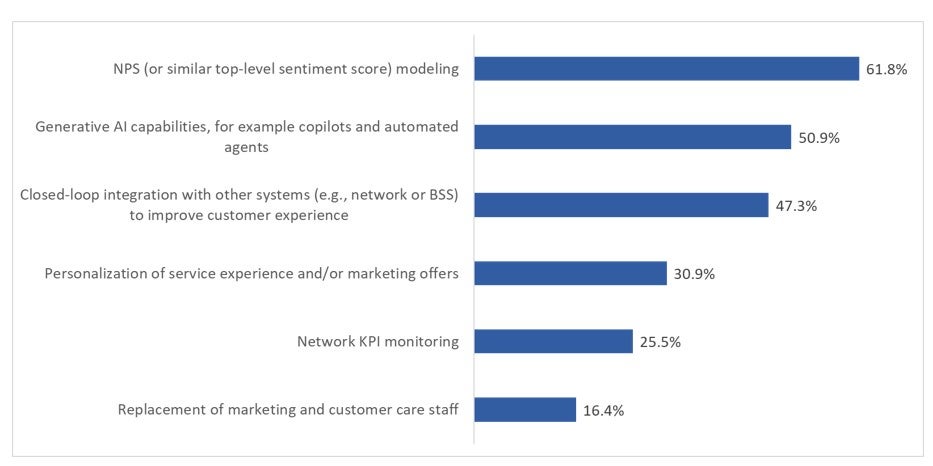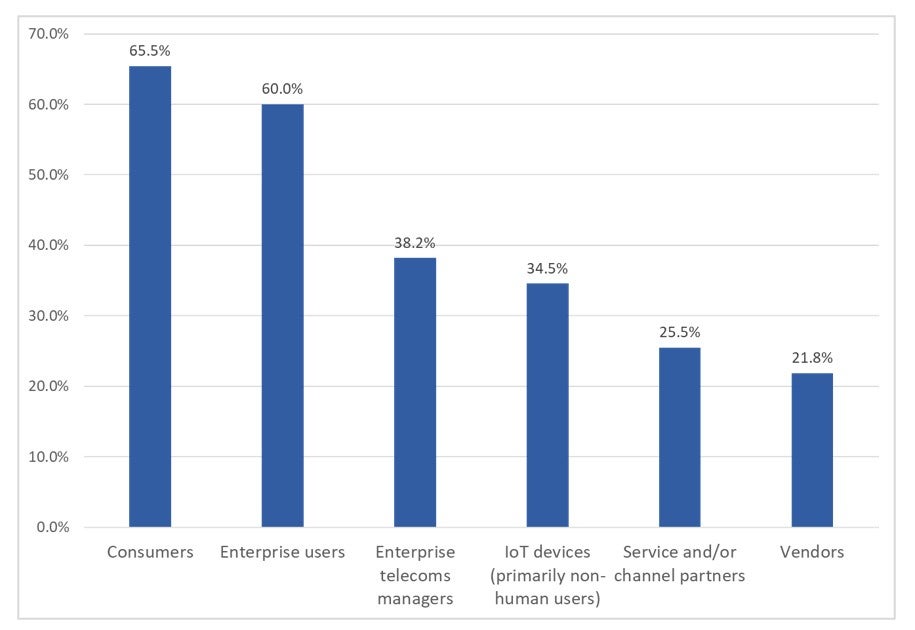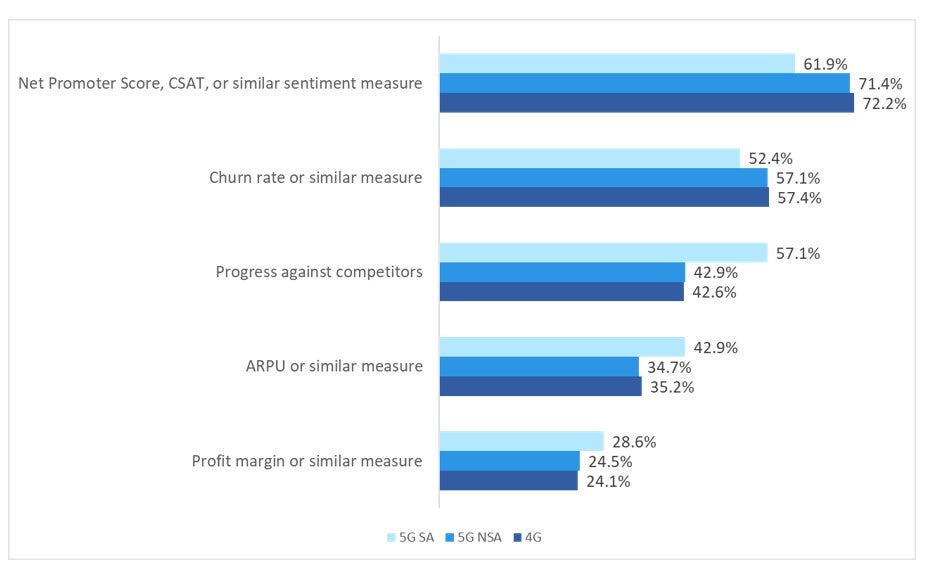The state of CEM in telecom
Almost every CSP has now accepted the need to judge itself at the top level by business-level KPIs rather than technical KPIs.
This does not mean that nobody looks at technical KPIs. Rather, it means that the technical KPIs – which are still vital indicators – are subordinated to the top-level customer experience metrics (CEM). If good performance on these technical KPIs leads to higher customer satisfaction, then they can be part of the effort to improve experience. If not, then they may remain important for operations, but they should not be part of the CEM effort.
For the past decade or so, carriers’ primary CEM KPI has been Net Promoter Score (NPS); our survey shows that 71% use that or a similar customer sentiment measure. The challenges of NPS and other customer sentiment measures are well known: first, it is affected by factors not directly under a CSP’s operational control: marketing campaigns, news stories, regulations, disasters, and so on. Second, since NPS relies on customer surveys, it is difficult to understand a customer’s experience in real time. CEM systems must therefore apply sophisticated analytics and Artificial Intelligence (AI) to model a customer’s experience in real time so that they may adjust that experience while they still have the opportunity to do so.
While NPS is by far the dominant experience metric in the industry, CSPs need a variety of metrics to see the whole picture. 57% of carriers in our survey also use a business-related KPI like churn rate to measure customer experience, under the assumption that better experiences lead to lower churn. Like NPS, churn is only measurable after it is too late to change, so CEM systems must be predictive: they must model the factors that go into these factors to determine which customers are most at risk of churning, and what service experience problems should be fixed to keep them on board.
Below these top-level KPIs, each touchpoint and stage of the customer journey will have one or more metrics attached to it. Network and service performance, naturally, are essential to experience, and are among the most conducive to real-time adjustment. Any other touchpoint that is captured should factor into these models as well. All told, scores of metrics must be correlated to address potential problems in customer experience, and to feed into the top-level KPIs. In one of the interviews we conducted for this research study, a Director at a CSP in the United Kingdom also pointed out that these sub-metrics will vary by service: demands for home broadband are different than for IoT networks, so the metrics tracked will be different as well. A CEM system must be able to judge a metric in terms of the product(s) it affects.
Artificial Intelligence (AI) is essential to this modelling, especially to any analysis that must occur in real time or near-real time. The volume of information required to approximate real-time experience for every customer is huge, and will only grow. One of the biggest differentiators between CEM systems is the quality of this real-time analysis and the technical resources needed to support it.

Don’t let policy changes catch you off guard. Stay proactive with real-time data and expert analysis.
By GlobalDataService and experience operations is growing so complex that it exceeds the ability of humans to manage it. Automation, therefore, is increasingly a requirement to all such systems. However, the problem with automation is that it makes it hard for CSP personnel to know what the system is doing. Generative AI (GenAI) helps to address this problem, enabling agent and copilot-driven interaction with the automated CEM system.
Figure 1: What functions are most important for your CEM system, whether current or future?

Interestingly, only 16% of respondents – the lowest response to any option – said that they wanted their CEM system to replace marketing and customer care staff. Given media speculation that Gen-AI will eventually replace human beings in these roles, it is notable that Gen-AI copilots and agents seem much more attractive to CSPs. Roughly half of CSPs are interested in Gen-AI for these abilities to support employee interaction with the CEM system.
5G’s impact on CEM
How long will it take for CSPs to meet their CEM goals?
Some 45% think it will happen in the next three to four years, while an additional 27% think it will take five to seven years. As carriers get more experience with 5G, however, we believe that their CEM goals may evolve.
Since 5G offers more capabilities to finely tune a customer’s experience, 5G CEM must also evolve. 5G provides better, more reliable connectivity, so CSPs can sell higher-value services with stricter SLAs. Services like fixed wireless access and vertical-specific IoT create new customer types and customer relationships. CSPs are starting to adjust to this new 5G reality, with significant minorities extending their definition of “customer” to non-traditional users:
Figure 2: How does your organization define the “customer” in Customer Experience Management?

The most dramatic finding of this question relates to IoT: just over a third of CSPs want their CEM systems to measure and adjust the experience of the devices that make up IoT networks in addition to devices associated with human listeners. GlobalData expects that percentage to increase over the next few years as more carriers adopt 5G Standalone (SA) (see next section). While CEM systems have been dealing with increasing user numbers for some time, extending the definition of “customer” to IoT devices will immediately increase the number of entities a CEM system must serve by an order of magnitude or even more.
We also expect that the number of CSPs that want their CEM system to serve their service and channel partners (currently 25.5%) will increase as industry initiatives involving service exposure and APIs increase the number of partners that are involved in a service. For example, a crop-dusting service using drones would involve, at a minimum, connectivity, the drones, the chemicals, location and mapping capabilities, and the professional services required to deliver the drone and chemicals to the location and to oversee the operation. Since it is highly unlikely that the CSP will be able to provide all those elements by itself, it will need an ecosystem of partners. The experience of those partners will also need to be managed, especially in cases where they are the primary sales and support channel for the end customer.
The 5G SA effect
5G Standalone (SA) is where 5G reaches its full purpose. 5G non-standalone – where 5G New Radio works with 4G’s enhanced packet core – can only deliver a better version of 4G’s high-bandwidth, best-effort connection. Implementing a 5G SA core, on the other hand, enables network slicing, which in turn enables CSPs to offer deterministic network performance. This ability presents new opportunities to offer guaranteed, tailored services, and this, in turn, creates new monetization opportunities.
The sooner CSPs implement 5G SA, the sooner they will be able to take advantage of these capabilities. Unfortunately, the majority of the industry has yet to make this transition: only 38% of survey respondents have achieved 5G SA. These CSPs are spread around the world, with the heaviest concentration in Southeast Asia.
Survey responses from the minority of CSPs that have implemented 5G SA can give an idea of what the broader industry will require from CEM system in the next five to seven years. In many cases, the requirements remain the same. In some cases, though, experience with 5G SA makes a difference:
Figure 3: What types of KPI do you use to measure your CEM progress?

- KPIs change. As the chart above shows, NPS is still the most common customer experience KPI, but there is a ten percent drop (from 72% to 62%) among 5G SA operators. Meanwhile, commercial metrics like Progress Against Competitors (from 43% to 57%) and ARPU (from 35% to 43% are substantially more important to those CSPs with 5G SA.
- The survey also indicates that 5G SA carriers are less likely to have their customer experience efforts driven by dedicated CEM organizations, but are twice as likely to have them driven by individual business areas.
- 5G SA CSPs are 10% less likely to report a lack of clear standards or goals, but, surprisingly, twice as likely to report a lack of internal consensus regarding CEM systems.
- Carriers with experience with standalone 5G are twice as likely to say that they do not have enough data to accomplish their CEM goals.
While these are still undeniably early days for 5G SA – and therefore our survey’s sample size is relatively small – these results highlight some of the practical effects of CEM in a 5G SA network.
Since network slicing enables CSPs to design services targeted to specific business areas, the focus tends to be more on driving revenue versus competitors (who may not have 5G SA yet). This is likely because individual business lines like enterprise services or IoT are charged with developing value-added services enabled by slicing, they are more likely to drive customer experience efforts as well. The UK interviewee we cited above also complained that his CEM system did a poor job analysing IoT devices, and therefore he had little idea about the customer experience in that area.
So why are 5G SA operators lesslikely than any other class of operators to say that they had enough data to support their CEM efforts? Especially since 5G SA networks produce more data than previous network generations? We believe that as more CSPs move to 5G SA, they find that their CEM data needs are greater than they anticipated. 5G service provision is more complex, and the 5G customer’s relationship to the carrier is more complex as well. Even as 5G SA produces more data, therefore, CSPs are finding that they have trouble using it to produce insights and actions when they are needed.
New business requirements create new technical requirements – and vice versa
The explosion of service types, customer types, slices, and SLAs produces new opportunities to serve customers, but equally produces an explosion in data. It is a double-edged sword: CSPs can derive more granular, predictive insights from the data that they gather across systems, however without a robust data strategy and sufficiently sophisticated systems, the data will quickly become unmanageable. Without strong data management and analysis, insights that could identify experience problems and lead to their remediation arrive too late to do any good. Or worse: not at all.
A modern CEM system must gather data across the CSP’s entire environment, from the edge of the network, the core, and all customer touch points and even the CSP’s store network. Then it must know what to process at the edge, what to discard, and what to send to the core for additional analysis. To do all of this, it must also understand all the myriad telco data formats and be able to process corrupted and other poor-quality data. To carry out real-time adjustments, the CEM system must employ AI that is powerful enough to handle this volume of streaming data. As CEM systems integrate with the rest of the carrier’s environment, scale rapidly in both functionality and data volume, and make more decisions and adjustments automatically, observability becomes a bigger issue. It is impractical for human employees to approve every decision in real time, so the system must enable them to understand what it is doing and why. It should also be able to run analyses and what-if scenarios for staff.
Gen-AI is useful for both of these needs. Its natural language capabilities can help CSP employees identify the most common experience problems and their likely causes, and may even be able to suggest a fix. Another essential product of Gen-AI is copilots, which help carrier personnel from operations to customer care dig deep into the CSP’s performance data, identify problems, and carry out fixes. Using Gen-AI copilots and agents to parse this data and suggest remediations will become ever more useful as CSP environments grow more and more complex.
The explosion in data also poses a problem for operational expenditure (OpEx). If storage and processing power scale linearly with data, CEM systems will become a budgetary black hole. Even the electricity they use will work against the CSP’s sustainability goals. A modern CEM system, therefore, must be able to do more with less. Data processing and AI inference must be more efficient than in prior generations, and modern data formats must be supported.
Content Original Link:
" target="_blank">
































































